人教版(2019)选择性必修第一册Unit 4 Body Language Reading and Thinking课件 (共73张PPT)
文档属性
| 名称 | 人教版(2019)选择性必修第一册Unit 4 Body Language Reading and Thinking课件 (共73张PPT) | 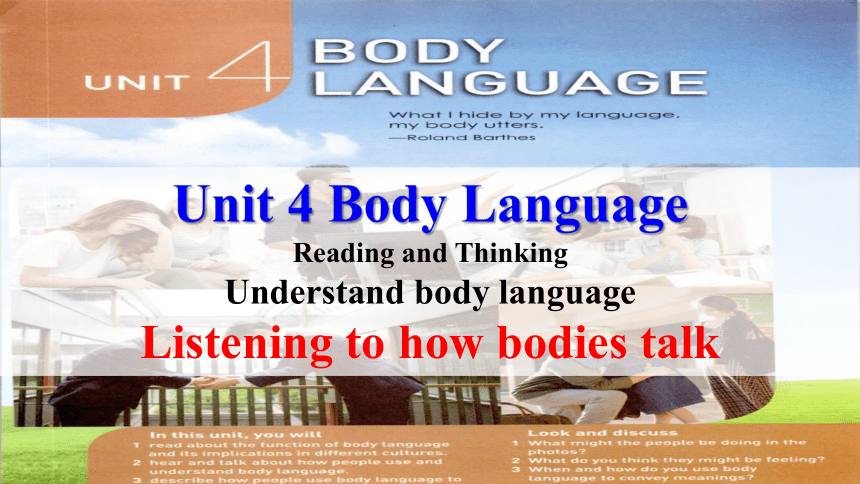 | |
| 格式 | pptx | ||
| 文件大小 | 18.4MB | ||
| 资源类型 | 教案 | ||
| 版本资源 | 人教版(2019) | ||
| 科目 | 英语 | ||
| 更新时间 | 2023-12-25 20:01:08 | ||
图片预览

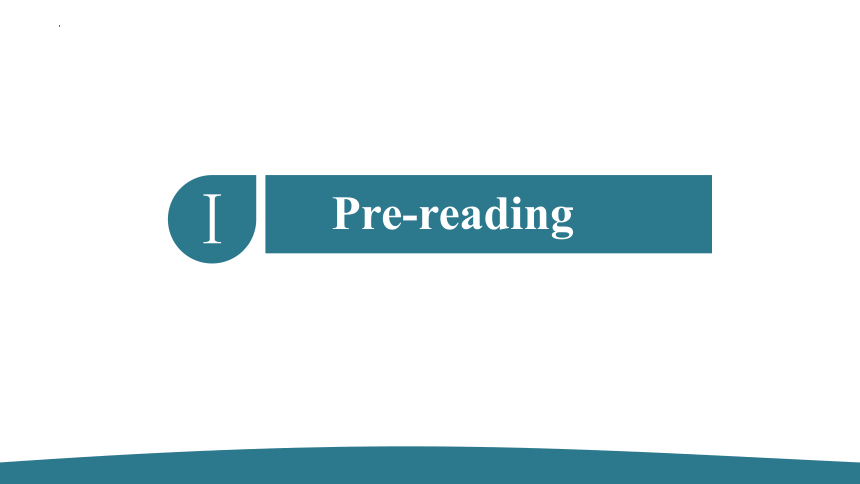
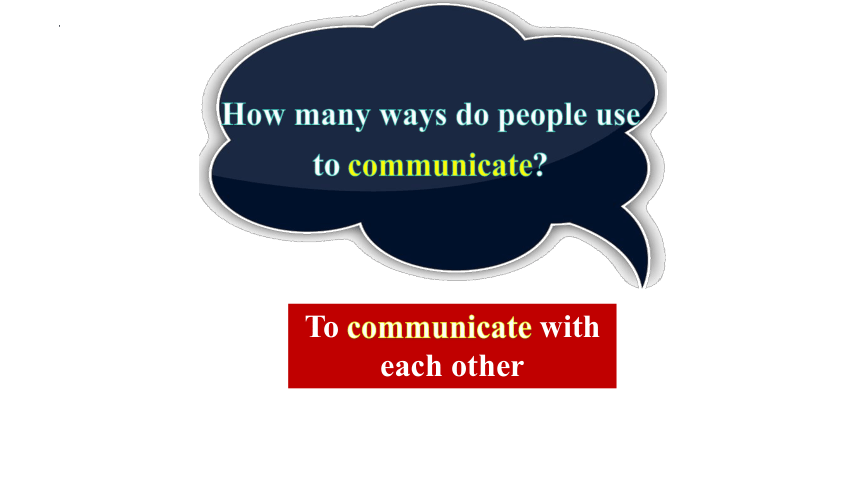
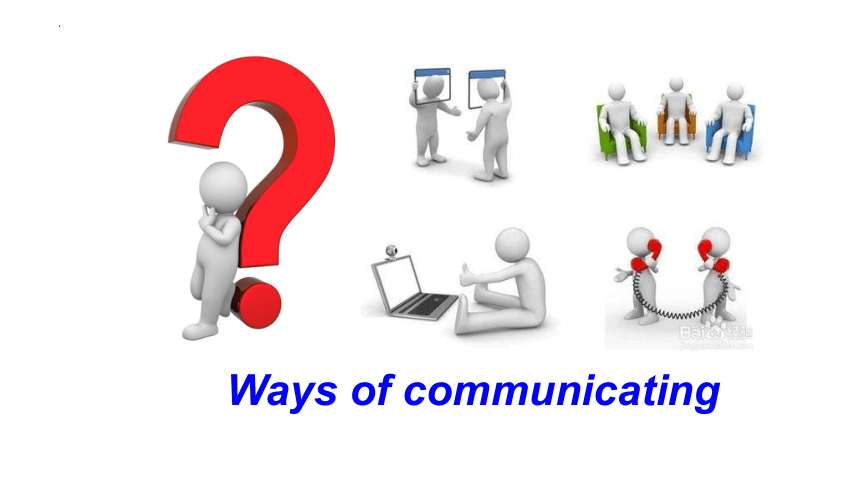
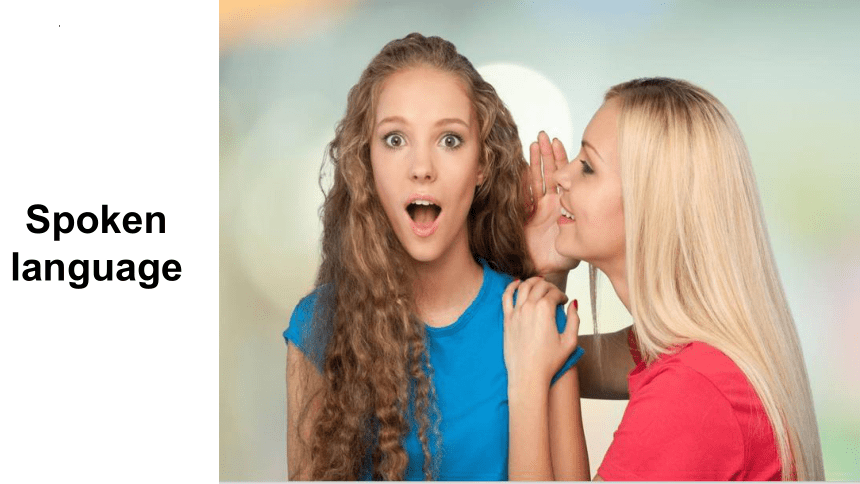
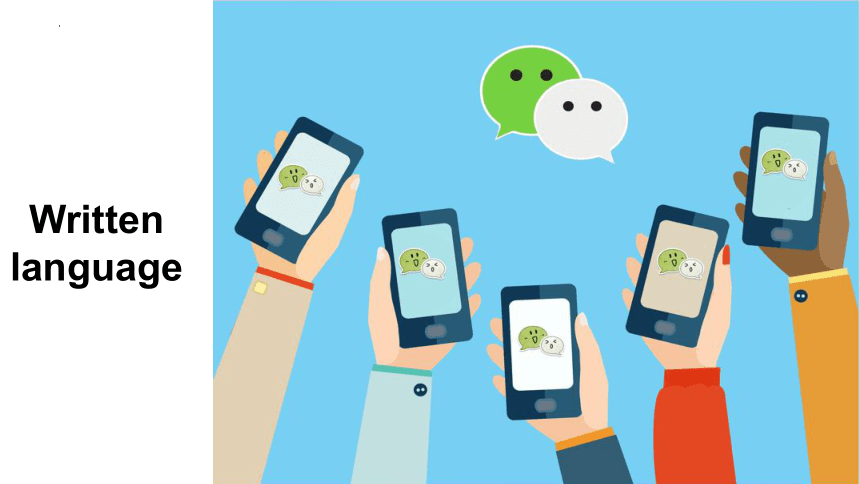
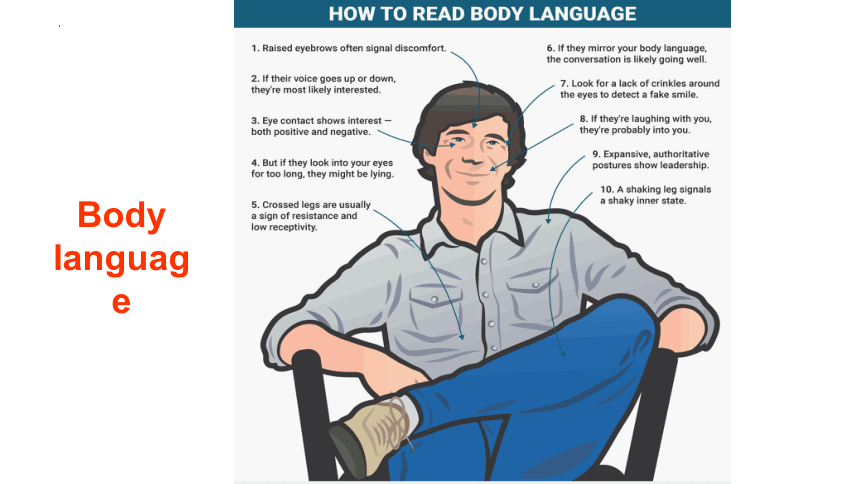
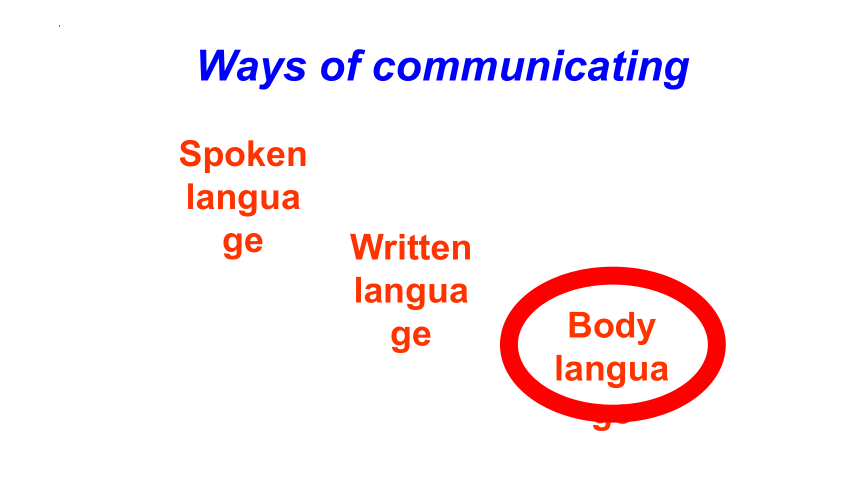
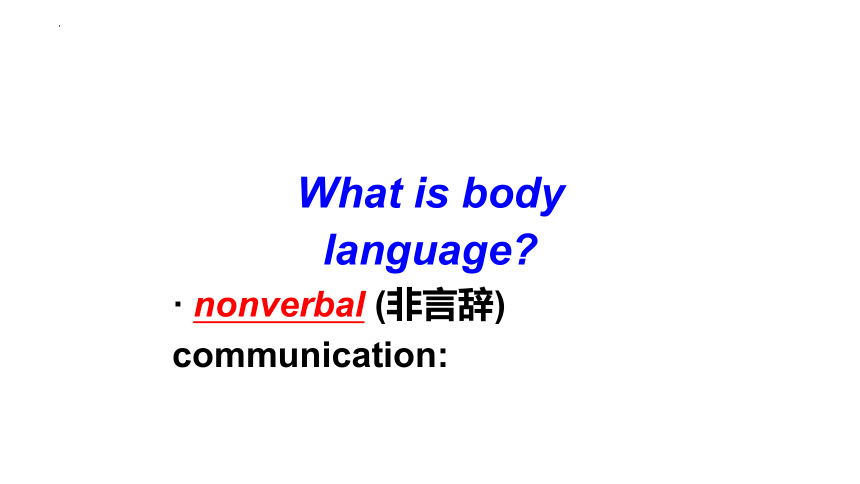
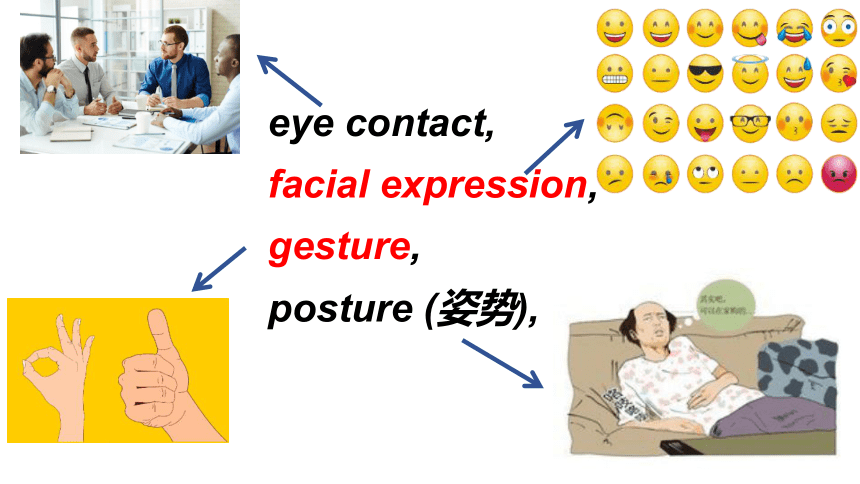
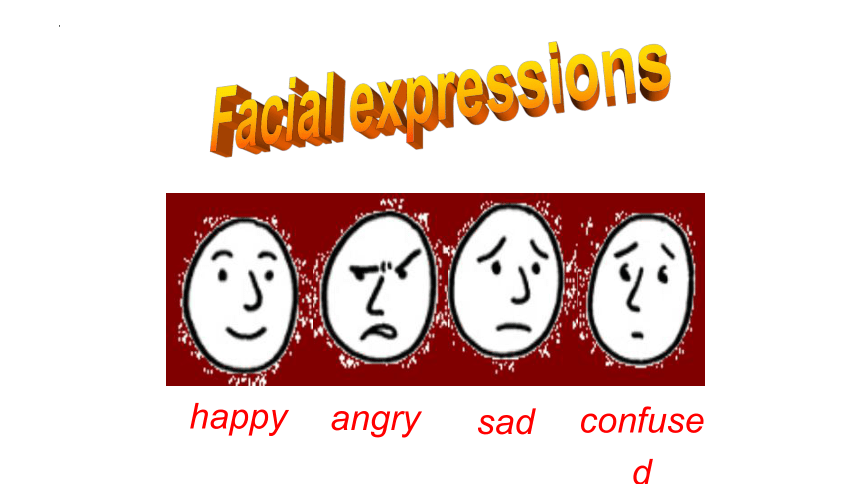
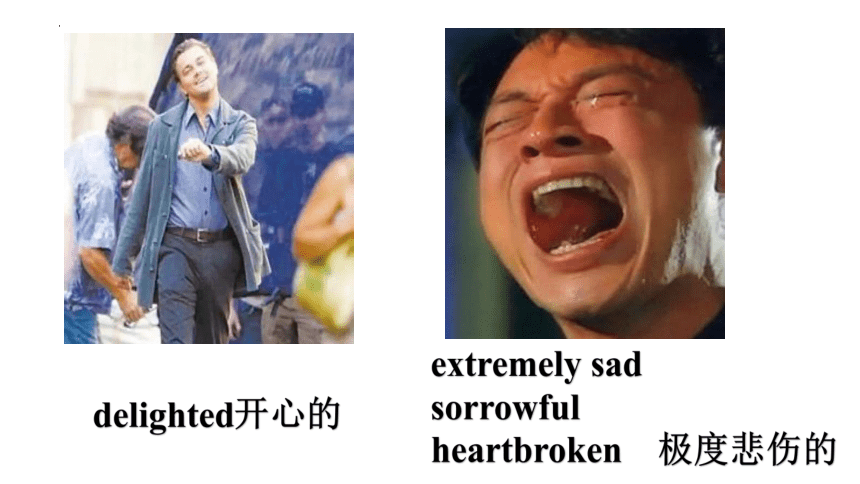
文档简介
(共73张PPT)
Unit 4 Body Language
Reading and Thinking
Understand body language
Listening to how bodies talk
Ⅰ
Pre-reading
What's the function of language
To communicate with each other
How many ways do people use to communicate
Ways of communicating
Spoken
language
Spoken
language
Written
language
Body
language
Spoken
language
Ways of communicating
Written
language
Body
language
What is body language
· nonverbal (非言辞) communication:
eye contact,
facial expression,
gesture,
posture (姿势),
Facial expressions
happy
angry
sad
confused
delighted开心的
extremely sad
sorrowful
heartbroken 极度悲伤的
surprised
astonished惊讶的
contemptuous轻蔑的
/k n tempt u s/
embarrassed
awkward尴尬的
angry 愤怒的
Gestures
Discuss what these gestures mean.
Good!
Bad!
Me
Come here!
I don’t know!
OK
Stop
Hush / Quiet
I love you.
Let's rock!
Good luck!
Come on!
Prediction
Understand body language
Listening To How Our Bodies Talk
Based on the title and the picture, predict what the passage may be about
The text may be about________________________________ ____________________________________________.
Probably the gesture “OK” _____________________.
how body language expresses our feelings, thoughts and opinions
is mentioned
What is the genre of the passage
A. A narration
B. An argumentation
C. An exposition
D. An application
Prediction
Ⅱ
While-reading
2. What’s the structure of the passage
A
B
C
①②
③④ ⑤⑥
①
②③④ ⑤ ⑥
①
②③④⑤ ⑥
varies
different meanings
differences
same meaning
body language
different uses
Para 1: Introduction
Para2-4:
The differences
Para 5: The similarities
Para 6: Different uses
1. Please find the topic sentence and key words of each paragraph.
Fast-reading
general
specific
总
|
分
Tip: the topic sentence usually hide on
the first or last sentence of that paragraph.
Read para 1 and then answer the following questions.
What does the word “interaction” in the first sentence in Paragraph 1 means
exchange
relationship
communication
reaction
Careful reading
Careful reading
Read para 2-5 , find the differences & similarities and then fill in the blanks.
Group work
Eye contact
Look down when talking to someone
Some countries
Middle Eastern
countries
Body language/
Gesture
Meaning
Country/Region
Body language/
Gesture
Meaning
Country/Region
OK sign
Body language/
Gesture
Meaning
Country/Region
nod the head
shake the head
Many countries
Bulgaria &
Southern Albania
Many countries
Bulgaria &
Southern Albania
elsewhere
kiss on the cheek
Placing your hands together and resting them on the side of your head while closing your eyes.
Moving your hand in circles over your stomach after a meal.
Body language/ Gesture
Meaning
Country/Region
para 2
para 3
para 4
para 5
Careful reading---para 2
Eye contact
Look down when talking to someone
Interest
Not polite
Respect
Some countries
Middle Eastern
countries
Japan
Body language/
Gesture
Meaning
Country/Region
Careful reading---para 3
Body language/
Gesture
Meaning
Country/Region
OK sign
Money
Japan
Zero
France
Not polite
Brazil/Germany
Yes
China
Careful reading---para 4
Body language/
Gesture
Meaning
Country/Region
nod the head
shake the head
Many countries
Bulgaria & Southern Albania
Many countries
Bulgaria & Southern Albania
France & Russia
elsewhere
to greet someone
to greet someone
no
yes
yes
no
kiss on the cheek
Shake hands
Bow from the waist
Nod the head
Careful reading---para 5
Placing your hands together and resting them on the side of your head while closing your eyes.
Moving your hand in circles over your stomach after a meal.
sleep
I’m full
everywhere
Body language/Gesture
Meaning
Country/Region
Which of the body language has many different uses
A. closing one’s eyes
B. placing one’s hands togather
C. moving one’s hand in circles over the stomach
D. smiling
Smile
smile
get through difficult situations and find friends
break down barriers
make yourself feel happier and stronger
not feeling down or lonely
apologise
ask for help
greet someone
start a conversation
Q1:What are the benefits of smile
Para 6
Q2: What can a smile can be used to do
Find out the varied sentence structures used to show uses of smiling
Some body language has many different uses. Perhaps the best example is smiling. A smile can help us get through difficult situations and find friends in a world of strangers. A smile can break down barriers. We can use a smile to apologise, to greet someone, to ask for help, or to start a conversation. Experts suggest smiling at yourself in the mirror to make yourself feel happier and stronger. And if we are feeling down or lonely,
there is nothing better than seeing the smiling face of a good friend.
Find out the varied sentence structures used to show uses of smiling
Para 6
小练笔:Can you think of some other uses of smiling
Firstly, a smile may help ease the tension in personal relationship.
Secondly, experts suggest smiling to keep ourselves healthy in both body and mind.
What’s more, there is no denying the fact that a smile could be an effective way to shorten the distance between people.
Hence, it is advisable for people to smile more, not only to beloved ones but also strangers. By doing so, we can built a more harmonious world and live a happier life.
缓解人际关系的紧张
使自己保持身心健康
缩短人与人之间的距离
Just as a famous saying goes, a smile costs nothing, but gives so much.
Post-reading
Ⅲ
Body Language
Introduction
learn a lot about __________________________
give us information about _________________
Body language in
different cultures
eye contact
“OK”
“yes” and “no”
ways of greeting
same meaning everywhere
“sleep”
The uses of body language
example: “smile”
get through difficult situations
________________________
make yourself feel happier and stronger
a way to ________________
is not approved of
Japan: money
France: _______
Brazil and __________: not polite
in many countries
in __________ and southern Albania
France and __________
Elsewhere
Middle Eastern countries
___________
___________
vary from culture
to culture
what people are thinking
their feelings
display interest
Japan
zero
Germany
Bulgaria
Russia
“I am full”
break down barriers
What advice on body language can you give a foreign friend on his/her first trip on China
How people greet
How talking with people
How sitting/standing
What he can do & What he can’t do!
In China,it is proper for us/good manners to... ...
In China,when people meet, it is proper for us to ________________________ rather than__________________, and keep _________________.
shake hands with others
kiss on the hand
a proper distance
Advice on body language in China
In China, it’s good manners to _____________ and have ___________ when talking to others.
keep smiling
eye contact
Advice on body language in China
In China,when we sit or stand, we’d better not __________________ or ______________________ .
sit with crossed legs
stand with crossed arms
Advice on body language in China
We use both words and body language __________(express) our thoughts and opinions in our ____________(interact) with other people. Just like spoken language, body language _________(vary) from culture to culture. The crucial thing is _________(use) body language in a way that is appropriate to the culture you are in. For example, _______ (make) eye contact is not appropriate to all cultures. Some gestures like the one for “OK’ have dfferent meanings in different cultures. Even the gestures we use for “yes”and “no”differ around the world. There are also differences ______ how we touch each other, how close we stand _____ someone we are talking to, and how we act when we meet or part. Such gestures _____ the ones for “sleep”and “I am full” seem to have _____ same meaning everywhere.Some body language has many different uses. One example is smiling.
to express
interactions
varies
using
making
in
to
as
the
Fill in the blanks according to the text.
Language Points
We use both words and body language to express our thoughts and opinions in our interactions with other people. We can learn a lot about what people are thinking by watching their body language. Words are important, but the way people stand, hold their arms, and move their hands can also give us information about their feelings.
_________________ 交流
____________________ 肢体语言
________________ 给某人某物
_________________ 情感
在与他人交流时,我们既使用言语也通过身势语来表达我们的想法和观点。通过观察别人的身势语,我们可以了解很多他们的想法。言语固然重要,但是人们站立、握紧手臂、移动双手的方式也能帮助我们了解他们的情绪。
interaction
body language
give sb sth
feeling
We use both words and body language to express our thoughts and opinions in our interactions with other people. We can learn a lot about what people are thinking by watching their body language. Words are important, but the way people stand, hold their arms, and move their hands can also give us information about their feelings.
定语从句
本句是并列复合句。people stand,hold their arms,and move their hands是定语从句,修饰先行词the way.关系词在从句中做状语,可用that/in which或省略掉。
way表示“方式、方法”在句中作先行词,定语从中缺状语时,定语从句引导词可用that / in which,或省略。
way作先行词的定语从句
1
e.g. I don’t like the way that he laughed at me.
=I don’t like the way in which he laughed at me.
=I don’t like the way he laughed at me.
way作先行词,定语从句中缺主语或宾语时,定语从句引导词用that /which(做动词后的宾语可省略)。
way作先行词的定语从句
2
e.g. He has given you the way that/which is best to solve the problem.
1. I admire the way _______________ he manages to see both sides of the question.
2. Suddenly, I remembered the way ___________ I had adopted to cope with the question.
3. Some poems describe something in a way __________ will give the reader a strong impression.
(that/in which)
(that/which)
that/which
Just like spoken language, body language varies from culture to culture. The crucial thing is using body language in a way that is appropriate to the culture you are in. For example, making eye contact—looking into someone’s eyes—in some countries is a way to display interest. In other countries, by contrast, eye contact is not always approved of. For example, in many Middle Eastern countries, men and women are not socially permitted to make eye contact. In Japan, it may demonstrate respect to look down when talking to an older person.
_________________ 从...到...不等
____________________ 一个做...的方法
_________________ 相比之下
_________________ 同意某人/某事
_________________表现,表达,证明
就像口头语言一样,身势语因文化而异。关键是使用身势语的方式要与你所处的文化相适应。例如,在有些国家,眼神交流——看着别人的眼睛——是表现兴趣的一种方式。相反,在另一些国家,眼神交流并不总是被认可。例如,在许多中东国家,男女不允许在社交场合进行眼神交流。在日本,和年长的人讲话时,目光向下以表示尊敬。
vary from ...to...
a way to do sth
by contrast
approve of sb/sth
demenstrate
2.①In Japan, it may demonstrate respect to look down when talking to an older person.
在日本,和年长的人说话时目光向下以表示尊敬。
②Placing your hands together and resting them on the side of your head while closing your eyes means “sleep”.
双手并拢放在头的一侧,同时闭上眼睛表示“睡觉”。
句式分析:在以上两个句子中,when talking和while closing都采用了省略的形式。完整的形式是when they are talking和while you are closing。
状语从句中的省略
状语从句的省略是指在时间、条件、比较、让步状语从句中,将从句的主语和be动词一起省略。通常需要具备以下条件:
(1)从句主语与主句主语一致,或从句主语为it;
(2)从句中含有be动词。
电子游戏如果落入一个错误的人手中就能够产生不良影响。
e.g.Video games can be a bad influence if (they are) left in the wrong hands.
单句语法填空
①Unless ___________(invite), I won’t go to his party this weekend.
②If _________(ask) to look after luggage for someone else, inform the police at once.
③While ____________(watch) TV, I heard a strange noise.
④They had no fault. They did everything as ________(tell).
⑤The weather was worse than ____________(expect).
invited
asked
watching
told
expected
The gesture for “OK” has different meanings in different cultures. In Japan, someone who witnesses another person employing the gesture might think it means money. In France, a person encountering an identical gesture may interpret it as meaning zero. However, you should avoid making this gesture in Brazil and Germany, as it is not considered polite.
_________________ 见证
____________________ 意味着
_________________ 相同的
_________________ 把...理解为
_________________ 避免做某事
“OK”这个手势在不同的文化中有不同的含义。在日本,如果看到另一个人用这个手势,可能认为这意味着钱。在法国,看到同一个手势的人可能会将其解读为“零”。但是在巴西和德国,你应该避免使用这个手势,因为它被认为是不礼貌的。
witness
mean
identical
interpret
avoid doing sth
Even the gestures we use for “yes” and “no” differ around the world. In many countries, shaking one’s head means “no”, and nodding means “yes”. By comparison, in Bulgaria and southern Albania, the gestures have the opposite meaning. There are also differences in how we touch each other, how close we stand to someone we are talking to, and how we act when we meet or part. In countries like France and Russia, people may kiss their friends on the cheek when they meet. Elsewhere, people favour shaking hands, bowing from the waist, or nodding the head when they meet someone else.
_____________ v. 不同于
_______________ (与...)相比较
_____________ v.较喜欢n.帮助
甚至我们用来表示“是”与“不是”的手势,在世界各地也不同。在许多国家,摇头表示“不”,点头表示“是”。相比之下,在保加利亚和阿尔巴尼亚南部,这两种手势的含义是相反的。差异还表现在我们彼此接触的方式,我们与谈话对象的距离,以及我们见面或告别时的行为。在法国和俄罗斯这样的国家,人们和朋友见面时可能会亲吻他们的脸颊。在其他地方,人们见面时更喜欢握手,弯腰鞠躬或者点头。
differ
by comparison
favour
3.In countries like France and Russia, people may kiss their friends on the cheek when they meet.
在法国和俄罗斯这样的国家,朋友见面时可能会亲吻脸颊。
句式分析:这是一个主从复合句。when they meet是when引导的时间状语从句,主句中kiss sb. on the cheek亲吻某人的面颊。
“及物动词+sb. +介词+the+表示身体部位的名称”结构
在该结构中,若身体部位不同,所用介词也不同,其具体用法如下:
拍,打:pat,strike,hit,beat
抓:catch,seize,grasp
拉,牵:pull,take,hold
in+the+柔软的部位(如face,eye,leg等)
on+the+坚硬的部位(如head,shoulder,back等)
by+the+可牵拉的部位(如hand,arm,ear等)
The angry father caught his son by the arm.
那个生气的父亲拽住了儿子的胳膊。
The naughty boy hit the man on the nose.
那个淘气的男孩打中了那个人的鼻子。
The teacher patted me on the shoulder, telling me the news.
老师拍着我的肩膀,告诉我这个消息。
The referee warned the player not to kick the rival in the stomach.
裁判警告这名选手不能踢竞争对手的肚子。
单句语法填空
①I hit the fellow ______ the head.
②The girl hit the boy ______ the mouth.
③The mother held the children ______ the hand.
④The little child took his grandma ______ the arm and walked her across the street.
on
in
by
by
Some gestures seem to have the same meaning everywhere. Placing your hands together and resting them on the side of your head while closing your eyes means “sleep”. A good way of saying “I am full” is moving your hand in circles over your stomach after a meal.
_____________ 似乎做...
_______________ 意味着...
_____________ 做某事的方法
有些手势似乎在每个地方都有相同的含义。双手并拢放在头的一侧,同时闭上眼睛表示“睡觉”。用餐后轻轻用手在胃部转圈表示“我饱了”。
seem to do
mean
way of doing sth
Some body language has many different uses. Perhaps the best example is smiling. A smile can help us get through difficult situations and find friends in a world of strangers. A smile can break down barriers. We can use a smile to apologise, to greet someone, to ask for help, or to start a conversation. Experts suggest smiling at yourself in the mirror to make yourself feel happier and stronger. And if we are feeling down or lonely, there is nothing better than seeing the smiling face of a good friend.
_____________通过;度过
_______________消除;分解;打破.
_____________建议做某事
_____________悲伤的;低落的
有些身势语有许多不同的用途。最好的例子也许是微笑。微笑可以帮助我们度过难关,在陌生人的世界里找到朋友。微笑可以打破障碍。我们可以用微笑来道歉,跟某人打招呼,寻求帮助或者开始对话。专家建议对着镜子微笑来让自己更快乐、更坚强。而且如果我们感到沮丧或孤独,没有什么比看到好朋友的笑脸更好的了。
get through
break down
suggest doing sth
down
4.And if we are feeling down or lonely, there is nothing better than seeing the smiling face of a good friend.
而且如果我们感到沮丧或孤独,没有什么比看到好朋友的笑脸更好的了。
句式分析:这是一个主从复合句。本句使用了“否定词+比较级”结构,否定词nothing与比较级better连用,表示最高级含义。
(1)在“否定词+比较级”句式中,常用的否定词有no,not,never,nothing,nobody,hardly等。
(2)最高级意义的多种表达法:
①否定词+形容词/副词比较级(+than)
②否定词+so/as+形容词/副词原级+as
单句语法填空
①No one could be __________________(generous); he has a heart of gold.
②Mr. Stevenson is great to work for—I really couldn’t ask for a __________(good) boss.
③Nothing is __________________(pleasant) than staying home listening to music.
④The weather couldn’t be _________(bad), so we will not go out.
more generous
better
more pleasant
worse
4.Can you describe a situation where you might smile when you don’t mean it
你能描述一个你可能不是真心微笑的情况吗?
句式分析:这是一个主从复合句。主句是Can you describe a situation,后面是where引导的定语从句,修饰先行词situation。
表示抽象地点的名词后接where引导的定语从句
当先行词为表示抽象地点的名词,如point,situation,case,stage,condition,scene,activity,position,site,spot等,后接定语从句时,若关系词在从句中作状语,需用关系副词where引导。
e.g. He got into a situation where it was hard to tell what was right and wrong.
e.g. After graduation she reached a point where she had to decide what to do.
他陷入一种难以分辨是非的局面。
毕业后她到了必须决定做什么的境地。
(1)表示抽象地点的名词后接定语从句时,如果关系词在从句中不作状语,而是作宾语或主语等,则关系词不能用where,而要用that/which。
特别提醒
Remember that there is still one point we must make clear at the conference tomorrow.
记住在明天的会议上我们还有一点必须弄清楚。
that/which
单句语法填空
①Self-driving is an area _________ China and the rest of the world are on the same starting line.
②Then I got to the point _________ I was staying up really late at night to get my work done.
③—Do you have anything to say for yourself
—Yes, there is one point ______________ I must insist on.
④It’s helpful to put children in a situation _________ they can see themselves differently,and this is ________ I agree with.
where
where
which/that
where
what
Unit 4 Body Language
Reading and Thinking
Understand body language
Listening to how bodies talk
Ⅰ
Pre-reading
What's the function of language
To communicate with each other
How many ways do people use to communicate
Ways of communicating
Spoken
language
Spoken
language
Written
language
Body
language
Spoken
language
Ways of communicating
Written
language
Body
language
What is body language
· nonverbal (非言辞) communication:
eye contact,
facial expression,
gesture,
posture (姿势),
Facial expressions
happy
angry
sad
confused
delighted开心的
extremely sad
sorrowful
heartbroken 极度悲伤的
surprised
astonished惊讶的
contemptuous轻蔑的
/k n tempt u s/
embarrassed
awkward尴尬的
angry 愤怒的
Gestures
Discuss what these gestures mean.
Good!
Bad!
Me
Come here!
I don’t know!
OK
Stop
Hush / Quiet
I love you.
Let's rock!
Good luck!
Come on!
Prediction
Understand body language
Listening To How Our Bodies Talk
Based on the title and the picture, predict what the passage may be about
The text may be about________________________________ ____________________________________________.
Probably the gesture “OK” _____________________.
how body language expresses our feelings, thoughts and opinions
is mentioned
What is the genre of the passage
A. A narration
B. An argumentation
C. An exposition
D. An application
Prediction
Ⅱ
While-reading
2. What’s the structure of the passage
A
B
C
①②
③④ ⑤⑥
①
②③④ ⑤ ⑥
①
②③④⑤ ⑥
varies
different meanings
differences
same meaning
body language
different uses
Para 1: Introduction
Para2-4:
The differences
Para 5: The similarities
Para 6: Different uses
1. Please find the topic sentence and key words of each paragraph.
Fast-reading
general
specific
总
|
分
Tip: the topic sentence usually hide on
the first or last sentence of that paragraph.
Read para 1 and then answer the following questions.
What does the word “interaction” in the first sentence in Paragraph 1 means
exchange
relationship
communication
reaction
Careful reading
Careful reading
Read para 2-5 , find the differences & similarities and then fill in the blanks.
Group work
Eye contact
Look down when talking to someone
Some countries
Middle Eastern
countries
Body language/
Gesture
Meaning
Country/Region
Body language/
Gesture
Meaning
Country/Region
OK sign
Body language/
Gesture
Meaning
Country/Region
nod the head
shake the head
Many countries
Bulgaria &
Southern Albania
Many countries
Bulgaria &
Southern Albania
elsewhere
kiss on the cheek
Placing your hands together and resting them on the side of your head while closing your eyes.
Moving your hand in circles over your stomach after a meal.
Body language/ Gesture
Meaning
Country/Region
para 2
para 3
para 4
para 5
Careful reading---para 2
Eye contact
Look down when talking to someone
Interest
Not polite
Respect
Some countries
Middle Eastern
countries
Japan
Body language/
Gesture
Meaning
Country/Region
Careful reading---para 3
Body language/
Gesture
Meaning
Country/Region
OK sign
Money
Japan
Zero
France
Not polite
Brazil/Germany
Yes
China
Careful reading---para 4
Body language/
Gesture
Meaning
Country/Region
nod the head
shake the head
Many countries
Bulgaria & Southern Albania
Many countries
Bulgaria & Southern Albania
France & Russia
elsewhere
to greet someone
to greet someone
no
yes
yes
no
kiss on the cheek
Shake hands
Bow from the waist
Nod the head
Careful reading---para 5
Placing your hands together and resting them on the side of your head while closing your eyes.
Moving your hand in circles over your stomach after a meal.
sleep
I’m full
everywhere
Body language/Gesture
Meaning
Country/Region
Which of the body language has many different uses
A. closing one’s eyes
B. placing one’s hands togather
C. moving one’s hand in circles over the stomach
D. smiling
Smile
smile
get through difficult situations and find friends
break down barriers
make yourself feel happier and stronger
not feeling down or lonely
apologise
ask for help
greet someone
start a conversation
Q1:What are the benefits of smile
Para 6
Q2: What can a smile can be used to do
Find out the varied sentence structures used to show uses of smiling
Some body language has many different uses. Perhaps the best example is smiling. A smile can help us get through difficult situations and find friends in a world of strangers. A smile can break down barriers. We can use a smile to apologise, to greet someone, to ask for help, or to start a conversation. Experts suggest smiling at yourself in the mirror to make yourself feel happier and stronger. And if we are feeling down or lonely,
there is nothing better than seeing the smiling face of a good friend.
Find out the varied sentence structures used to show uses of smiling
Para 6
小练笔:Can you think of some other uses of smiling
Firstly, a smile may help ease the tension in personal relationship.
Secondly, experts suggest smiling to keep ourselves healthy in both body and mind.
What’s more, there is no denying the fact that a smile could be an effective way to shorten the distance between people.
Hence, it is advisable for people to smile more, not only to beloved ones but also strangers. By doing so, we can built a more harmonious world and live a happier life.
缓解人际关系的紧张
使自己保持身心健康
缩短人与人之间的距离
Just as a famous saying goes, a smile costs nothing, but gives so much.
Post-reading
Ⅲ
Body Language
Introduction
learn a lot about __________________________
give us information about _________________
Body language in
different cultures
eye contact
“OK”
“yes” and “no”
ways of greeting
same meaning everywhere
“sleep”
The uses of body language
example: “smile”
get through difficult situations
________________________
make yourself feel happier and stronger
a way to ________________
is not approved of
Japan: money
France: _______
Brazil and __________: not polite
in many countries
in __________ and southern Albania
France and __________
Elsewhere
Middle Eastern countries
___________
___________
vary from culture
to culture
what people are thinking
their feelings
display interest
Japan
zero
Germany
Bulgaria
Russia
“I am full”
break down barriers
What advice on body language can you give a foreign friend on his/her first trip on China
How people greet
How talking with people
How sitting/standing
What he can do & What he can’t do!
In China,it is proper for us/good manners to... ...
In China,when people meet, it is proper for us to ________________________ rather than__________________, and keep _________________.
shake hands with others
kiss on the hand
a proper distance
Advice on body language in China
In China, it’s good manners to _____________ and have ___________ when talking to others.
keep smiling
eye contact
Advice on body language in China
In China,when we sit or stand, we’d better not __________________ or ______________________ .
sit with crossed legs
stand with crossed arms
Advice on body language in China
We use both words and body language __________(express) our thoughts and opinions in our ____________(interact) with other people. Just like spoken language, body language _________(vary) from culture to culture. The crucial thing is _________(use) body language in a way that is appropriate to the culture you are in. For example, _______ (make) eye contact is not appropriate to all cultures. Some gestures like the one for “OK’ have dfferent meanings in different cultures. Even the gestures we use for “yes”and “no”differ around the world. There are also differences ______ how we touch each other, how close we stand _____ someone we are talking to, and how we act when we meet or part. Such gestures _____ the ones for “sleep”and “I am full” seem to have _____ same meaning everywhere.Some body language has many different uses. One example is smiling.
to express
interactions
varies
using
making
in
to
as
the
Fill in the blanks according to the text.
Language Points
We use both words and body language to express our thoughts and opinions in our interactions with other people. We can learn a lot about what people are thinking by watching their body language. Words are important, but the way people stand, hold their arms, and move their hands can also give us information about their feelings.
_________________ 交流
____________________ 肢体语言
________________ 给某人某物
_________________ 情感
在与他人交流时,我们既使用言语也通过身势语来表达我们的想法和观点。通过观察别人的身势语,我们可以了解很多他们的想法。言语固然重要,但是人们站立、握紧手臂、移动双手的方式也能帮助我们了解他们的情绪。
interaction
body language
give sb sth
feeling
We use both words and body language to express our thoughts and opinions in our interactions with other people. We can learn a lot about what people are thinking by watching their body language. Words are important, but the way people stand, hold their arms, and move their hands can also give us information about their feelings.
定语从句
本句是并列复合句。people stand,hold their arms,and move their hands是定语从句,修饰先行词the way.关系词在从句中做状语,可用that/in which或省略掉。
way表示“方式、方法”在句中作先行词,定语从中缺状语时,定语从句引导词可用that / in which,或省略。
way作先行词的定语从句
1
e.g. I don’t like the way that he laughed at me.
=I don’t like the way in which he laughed at me.
=I don’t like the way he laughed at me.
way作先行词,定语从句中缺主语或宾语时,定语从句引导词用that /which(做动词后的宾语可省略)。
way作先行词的定语从句
2
e.g. He has given you the way that/which is best to solve the problem.
1. I admire the way _______________ he manages to see both sides of the question.
2. Suddenly, I remembered the way ___________ I had adopted to cope with the question.
3. Some poems describe something in a way __________ will give the reader a strong impression.
(that/in which)
(that/which)
that/which
Just like spoken language, body language varies from culture to culture. The crucial thing is using body language in a way that is appropriate to the culture you are in. For example, making eye contact—looking into someone’s eyes—in some countries is a way to display interest. In other countries, by contrast, eye contact is not always approved of. For example, in many Middle Eastern countries, men and women are not socially permitted to make eye contact. In Japan, it may demonstrate respect to look down when talking to an older person.
_________________ 从...到...不等
____________________ 一个做...的方法
_________________ 相比之下
_________________ 同意某人/某事
_________________表现,表达,证明
就像口头语言一样,身势语因文化而异。关键是使用身势语的方式要与你所处的文化相适应。例如,在有些国家,眼神交流——看着别人的眼睛——是表现兴趣的一种方式。相反,在另一些国家,眼神交流并不总是被认可。例如,在许多中东国家,男女不允许在社交场合进行眼神交流。在日本,和年长的人讲话时,目光向下以表示尊敬。
vary from ...to...
a way to do sth
by contrast
approve of sb/sth
demenstrate
2.①In Japan, it may demonstrate respect to look down when talking to an older person.
在日本,和年长的人说话时目光向下以表示尊敬。
②Placing your hands together and resting them on the side of your head while closing your eyes means “sleep”.
双手并拢放在头的一侧,同时闭上眼睛表示“睡觉”。
句式分析:在以上两个句子中,when talking和while closing都采用了省略的形式。完整的形式是when they are talking和while you are closing。
状语从句中的省略
状语从句的省略是指在时间、条件、比较、让步状语从句中,将从句的主语和be动词一起省略。通常需要具备以下条件:
(1)从句主语与主句主语一致,或从句主语为it;
(2)从句中含有be动词。
电子游戏如果落入一个错误的人手中就能够产生不良影响。
e.g.Video games can be a bad influence if (they are) left in the wrong hands.
单句语法填空
①Unless ___________(invite), I won’t go to his party this weekend.
②If _________(ask) to look after luggage for someone else, inform the police at once.
③While ____________(watch) TV, I heard a strange noise.
④They had no fault. They did everything as ________(tell).
⑤The weather was worse than ____________(expect).
invited
asked
watching
told
expected
The gesture for “OK” has different meanings in different cultures. In Japan, someone who witnesses another person employing the gesture might think it means money. In France, a person encountering an identical gesture may interpret it as meaning zero. However, you should avoid making this gesture in Brazil and Germany, as it is not considered polite.
_________________ 见证
____________________ 意味着
_________________ 相同的
_________________ 把...理解为
_________________ 避免做某事
“OK”这个手势在不同的文化中有不同的含义。在日本,如果看到另一个人用这个手势,可能认为这意味着钱。在法国,看到同一个手势的人可能会将其解读为“零”。但是在巴西和德国,你应该避免使用这个手势,因为它被认为是不礼貌的。
witness
mean
identical
interpret
avoid doing sth
Even the gestures we use for “yes” and “no” differ around the world. In many countries, shaking one’s head means “no”, and nodding means “yes”. By comparison, in Bulgaria and southern Albania, the gestures have the opposite meaning. There are also differences in how we touch each other, how close we stand to someone we are talking to, and how we act when we meet or part. In countries like France and Russia, people may kiss their friends on the cheek when they meet. Elsewhere, people favour shaking hands, bowing from the waist, or nodding the head when they meet someone else.
_____________ v. 不同于
_______________ (与...)相比较
_____________ v.较喜欢n.帮助
甚至我们用来表示“是”与“不是”的手势,在世界各地也不同。在许多国家,摇头表示“不”,点头表示“是”。相比之下,在保加利亚和阿尔巴尼亚南部,这两种手势的含义是相反的。差异还表现在我们彼此接触的方式,我们与谈话对象的距离,以及我们见面或告别时的行为。在法国和俄罗斯这样的国家,人们和朋友见面时可能会亲吻他们的脸颊。在其他地方,人们见面时更喜欢握手,弯腰鞠躬或者点头。
differ
by comparison
favour
3.In countries like France and Russia, people may kiss their friends on the cheek when they meet.
在法国和俄罗斯这样的国家,朋友见面时可能会亲吻脸颊。
句式分析:这是一个主从复合句。when they meet是when引导的时间状语从句,主句中kiss sb. on the cheek亲吻某人的面颊。
“及物动词+sb. +介词+the+表示身体部位的名称”结构
在该结构中,若身体部位不同,所用介词也不同,其具体用法如下:
拍,打:pat,strike,hit,beat
抓:catch,seize,grasp
拉,牵:pull,take,hold
in+the+柔软的部位(如face,eye,leg等)
on+the+坚硬的部位(如head,shoulder,back等)
by+the+可牵拉的部位(如hand,arm,ear等)
The angry father caught his son by the arm.
那个生气的父亲拽住了儿子的胳膊。
The naughty boy hit the man on the nose.
那个淘气的男孩打中了那个人的鼻子。
The teacher patted me on the shoulder, telling me the news.
老师拍着我的肩膀,告诉我这个消息。
The referee warned the player not to kick the rival in the stomach.
裁判警告这名选手不能踢竞争对手的肚子。
单句语法填空
①I hit the fellow ______ the head.
②The girl hit the boy ______ the mouth.
③The mother held the children ______ the hand.
④The little child took his grandma ______ the arm and walked her across the street.
on
in
by
by
Some gestures seem to have the same meaning everywhere. Placing your hands together and resting them on the side of your head while closing your eyes means “sleep”. A good way of saying “I am full” is moving your hand in circles over your stomach after a meal.
_____________ 似乎做...
_______________ 意味着...
_____________ 做某事的方法
有些手势似乎在每个地方都有相同的含义。双手并拢放在头的一侧,同时闭上眼睛表示“睡觉”。用餐后轻轻用手在胃部转圈表示“我饱了”。
seem to do
mean
way of doing sth
Some body language has many different uses. Perhaps the best example is smiling. A smile can help us get through difficult situations and find friends in a world of strangers. A smile can break down barriers. We can use a smile to apologise, to greet someone, to ask for help, or to start a conversation. Experts suggest smiling at yourself in the mirror to make yourself feel happier and stronger. And if we are feeling down or lonely, there is nothing better than seeing the smiling face of a good friend.
_____________通过;度过
_______________消除;分解;打破.
_____________建议做某事
_____________悲伤的;低落的
有些身势语有许多不同的用途。最好的例子也许是微笑。微笑可以帮助我们度过难关,在陌生人的世界里找到朋友。微笑可以打破障碍。我们可以用微笑来道歉,跟某人打招呼,寻求帮助或者开始对话。专家建议对着镜子微笑来让自己更快乐、更坚强。而且如果我们感到沮丧或孤独,没有什么比看到好朋友的笑脸更好的了。
get through
break down
suggest doing sth
down
4.And if we are feeling down or lonely, there is nothing better than seeing the smiling face of a good friend.
而且如果我们感到沮丧或孤独,没有什么比看到好朋友的笑脸更好的了。
句式分析:这是一个主从复合句。本句使用了“否定词+比较级”结构,否定词nothing与比较级better连用,表示最高级含义。
(1)在“否定词+比较级”句式中,常用的否定词有no,not,never,nothing,nobody,hardly等。
(2)最高级意义的多种表达法:
①否定词+形容词/副词比较级(+than)
②否定词+so/as+形容词/副词原级+as
单句语法填空
①No one could be __________________(generous); he has a heart of gold.
②Mr. Stevenson is great to work for—I really couldn’t ask for a __________(good) boss.
③Nothing is __________________(pleasant) than staying home listening to music.
④The weather couldn’t be _________(bad), so we will not go out.
more generous
better
more pleasant
worse
4.Can you describe a situation where you might smile when you don’t mean it
你能描述一个你可能不是真心微笑的情况吗?
句式分析:这是一个主从复合句。主句是Can you describe a situation,后面是where引导的定语从句,修饰先行词situation。
表示抽象地点的名词后接where引导的定语从句
当先行词为表示抽象地点的名词,如point,situation,case,stage,condition,scene,activity,position,site,spot等,后接定语从句时,若关系词在从句中作状语,需用关系副词where引导。
e.g. He got into a situation where it was hard to tell what was right and wrong.
e.g. After graduation she reached a point where she had to decide what to do.
他陷入一种难以分辨是非的局面。
毕业后她到了必须决定做什么的境地。
(1)表示抽象地点的名词后接定语从句时,如果关系词在从句中不作状语,而是作宾语或主语等,则关系词不能用where,而要用that/which。
特别提醒
Remember that there is still one point we must make clear at the conference tomorrow.
记住在明天的会议上我们还有一点必须弄清楚。
that/which
单句语法填空
①Self-driving is an area _________ China and the rest of the world are on the same starting line.
②Then I got to the point _________ I was staying up really late at night to get my work done.
③—Do you have anything to say for yourself
—Yes, there is one point ______________ I must insist on.
④It’s helpful to put children in a situation _________ they can see themselves differently,and this is ________ I agree with.
where
where
which/that
where
what
